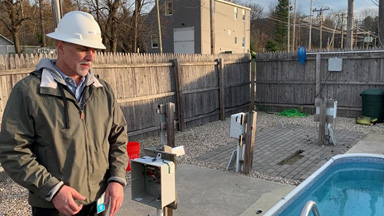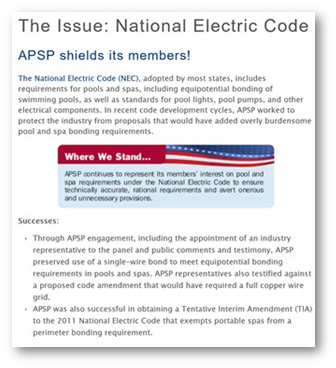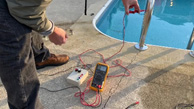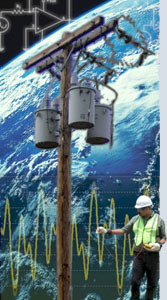
In the Fall of 2018, EPRI opened a test facility to the public so that they could witness testing at the EPRI swimming pool assessment infrastructure within EPRI’s laboratory in Lenox, Massachusetts. Those tests demonstrated that during 120-Vac line faults, over 100 milliamps of current can be conducted through a human body when a single bare copper ring that is compliant with NEC Article 680.26 is used as the equipotential bonding means. This finding reveals a significant safety gap in the current version of the NEC (National Electrical Code). The key takeaway from the testing is that it is not possible to develop an equipotential bond (with the dirt or the earth) beneath the pool deck. However, a safe zone of equipotential protection can be created with enough conductive grid material either within or beneath the deck surface. The safe zone will keep humans who stand on that surface at a reasonably close equipotential, regardless of what else is impressed during 60-Hz line faults or from the buildup of any static charge.

EPRI presented the test results and conclusions regarding safety gaps to the NEC’s code-making panel (17 members) in October of 2018, and a majority of the members present that day voted to recommend an appropriate code change that would protect pool users when these uncleared electrical faults happen. A day later, that vote was inexplicably overturned after several panel members met with opponents of the proposal and changed their vote. It is not entirely clear why a few of members of the NEC code-making panel would even remotely consider changing their minds on a code enhancement related to a safety gap, but the following screen capture (taken on 11-21-2018) from one of the opposition parties’ websites explains a possible cost-over-safety aspect of their argument.

Although the NEC is not likely to move quickly to eliminate this safety gap in the existing code, EPRI has a public-safety mission that warrants promoting fact-based scientific findings and recommendations as detailed in the following paragraphs.
With the concepts of equipotential surfaces and electrical bonding well understood, the pool industry is able to develop recommendations to promote effective electrical safety in pool environments. The following sections describe leading practices for safe design for new construction and for retrofit. Users of these recommendations should keep in mind the two key foundational pillars of safety that underpin this work:
- Equipotential – The pool water and the surface of the decking areas within the span of human contact need to be at near or the same voltage potential under all conditions. This is only achievable if there is a conductive metallic grid (either within or under the pool deck area), and that grid must be adequately interconnected or bonded to the pool water.
- Electrical Interconnectivity – No bonding or interconnection pathways should exist to allow an accidental or intentional connection between the pool water and the grounding and bonding network of the facility electric power system.
Note that although ground fault circuit interrupters should be used on all electric circuits feeding pool circulation equipment and lighting, a circuit interrupter will not provide protection for item B.
EPRI Recommended Practice for New Construction (Both Conductive and Non-Conductive Pools)
Follow and adhere to all equipotential bonding requirements of the 2005 version of the National Electrical Code (NEC Article 680.26 -2005). This particular version of the code requires that for conductive pool types (such as rebar-formed concrete), the rebar grid must extend three feet out from the inner side of all pool walls. This gridded shell and gridded deck creates an equipotential surface between the pool water and the three-foot extension where people sit or stand poolside.
The 2005 code version also states that if the pool is a non-conductive type, or for construction where the rebar used is encapsulated in an insulating compound, or if the deck is going to be comprised of materials other than poured concrete, a supplemental copper grid is required for the deck. This version of the code disallows the single bare copper conductor, which has been shown by multiple test organizations to be inadequate and unsafe during electrical fault conditions.

The important difference between the grid and the single wire is that the equipotential bonding grid creates a safe zone for the deck surface, whereas a single wire does not. Further, EPRI also recommends an enhanced zone of protection, whereby the installer extends the grid out to at least four feet from the pool water and installs that grid as close to the surface of the deck as feasible. EPRI believes that a four-foot zone of protection provides an additional factor of safety for people using a pool surface skimmer with a metal hand.
The following is offered as a complete specification:
- Deck Area Grid – A conductive metallic grid (of 12 inch by 12 inch or smaller squares) should be used for any perimeter decking areas within four feet of the pool’s inner wall.
- Width and Depth – It is preferred to encase the grid in the decking material. However, if the grid cannot be encased within the decking material, it should be as close to the surface of the decking subgrade as feasible and should be made of a material and connectors that are suitable for direct burial and suitable for longevity in an environment of chemically treated water.
- Underwater Lighting – No 120-Vac lighting and no metal conduits in conductive niches or metal retaining rings should be used in the pool walls or within five feet of the pool area. Only two-conductor, 12-V LED lighting in non-conductive enclosures and non-conductive conduit should be used. The key point here is to eliminate any metal and ensure that nothing metallic or electrically conductive approaches the pool inner wall. Further, if low-voltage (such as 12-volt) LED lighting is used, the two conductors feeding the LED fixtures must be electrically isolated from the grounding and bonding infrastructure.
- Bonded Parts – No conductive metal parts should be installed within five feet of the inner pool wall. This means no metal handrails, no metal ladders, and no other conductive hardware. Suitable high-impact vinyl versions of this hardware are available.
- Bonding Conductors for Pumps and Heaters – NEC Article 680.26 generally requires a bonding conductor that connects to all of the other electrical equipment (such as pumps, heaters, and control units) and then connects all of this equipment back to the equipotential bonding ring of the pool area. The bonding connection over to the pool area is not endorsed by EPRI because this connection provides an unintended pathway for electrical faults to get to the pool water.
As an alternative means, EPRI recommends that all electrical equipment be located in the same area and that the equipment bonding lugs be interconnected to one another and connected directly to the ground bus of the electric subpanel. This provides a suitable pathway for equipment faults to be cleared by the overcurrent protective device without exposing pool users to the dangers posed by a neighbor’s fault or by a fault on other circuit in the facility.
Installers should be aware that the recommendation in item E) is new, and most authorities having jurisdiction will be hesitant to allow this deviation from current practice. If that is the case, refer them to this EPRI publication, which articulates the unsafe aspects of bringing the circulating system bonding conductor over to the pool’s bonding network.
If the authority having jurisdiction is still concerned about the circulation system being interconnected with the pool water, a suitable workaround is to put a water-bonding device with at least nine square inches of surface area directly into the circulation pipes where the pipe connects to the pump. Be sure to use the version that inserts at the circulating pump and do not use the version that inserts at the skimmer end.
EPRI Recommended Practice for Existing In-Ground Pools (Both Conductive and Non-Conductive)
All equipotential bonding means in the vicinity of a chemically treated swimming pool will undergo corrosive aging over time. Therefore, for existing pool construction, the following is recommended:
- An annual inspection of the water voltage gradient.
- An annual inspection of the equipotential bonding integrity.
- Monthly physical operation and testing of all GFCIs and all breakers.
Note: For each of the tests, all electrical equipment supporting the pool area should be operational and energized.
The water voltage gradient test can be most simply accomplished by walking the perimeter of the pool and using a device similar to the one described at THIS WEBSITE, or else by measuring with a voltmeter and two floating electrodes a few feet apart.
The assessment of equipotential bonding can be accomplished with measurements detailed in IEEE 1695 -2016, Guide to Understanding, Diagnosing, and Mitigating Stray and Contact Voltage. Simply put, we are ensuring that all bonded parts are maintaining a low-impedance connection between one another and that no corrosion to the bonding grid has occurred over time. If there is a missing bond or if the connections have corroded over time, the continuity test with an ohm meter will generate a resistance greater than one half ohm, and a measurement of the voltage difference between the ground rod of the power service and the various bonded parts in the pool area may show a voltage difference when the pool-circulation equipment is operating. For most meters, the voltage difference is measured across a load resistor, and the value of the voltage difference is compared to the value obtained by just touching the meter test leads together.
If a voltage difference is identified between any of the bonded parts specified in NEC 680.26 or between the bonded parts and the water, the pool should be closed to use, and remediation is recommended as follows:
- The pool owner should consider a conductive metallic grid (of 12 inch by 12 inch or smaller squares) for any perimeter decking areas within four feet of the pool inner wall. For both conductive and non-conductive shells, this grid should be bonded to an NEC 680.26-compliant equipotential bonding ring at four or more different points around the pool perimeter and bonded to the water through approved means.
- If option A) is not feasible, the pool owner should consider removal of all conductive elements that are physically accessible to swimmers, including 120-V underwater lighting and wiring. Conductive ladders, handrails, and poles used to skim debris off the water surface should be replaced with non-conductive and non-metallic hardware.
- Lastly, because the circulation system for the pool water uses a pump and many times uses a supplemental heater, the NEC requires that they be bonded to the other conductive parts in the pool area. Adhere to the recommendations in item E) from the new construction pools list in the previous section.

